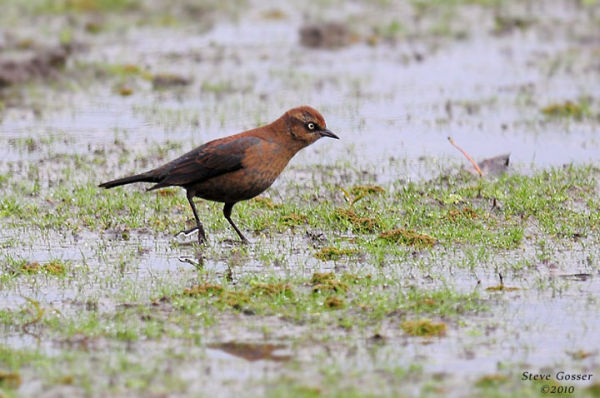
When I read the bird reports from eastern Pennsylvania I’m always a little jealous because they have such a wide variety of birds over there.
It’s unusual to see a species in western Pennsylvania that’s not common in the east as well. Rusty blackbirds are an exception to that rule.
Rusty blackbirds (Euphagus carolinus) breed in Alaska and across Canada in wooded swamps and willow thickets. No matter where they are, they prefer to keep their feet wet which means that glaciated, swampy, northwestern Pennsylvania is a great place to find them on migration.
Last Sunday I visited Glade Dam Lake in Butler County where a lot of the area is marked “subject to inundation” on the map. In other words, it’s a swamp ideal for rusty blackbirds — and they were there.
Because rusty blackbirds are declining and sometimes rare I’m always careful to get a good look at them before I get excited. Distant backlit flocks are difficult to identify in flight because they’re the same size as red-winged blackbirds. Up close they’re easy. Though they’re black in the breeding season they become rust-colored in the fall and their yellow eyes stand out. Even their voice is rusty, a noise that resembles a creaking rusty gate.
At Glade Dam Lake I heard their voices but couldn’t see them in the swampy woods until the flock grazed its way to the parking lot. Ta dah! Rusties!
Steve Gosser had a better view of them at Mosquito Lake, Ohio on October 14. That’s where he took this picture and a video of rusty blackbirds doing their favorite thing: keeping their feet wet.
(photo by Steve Gosser)
I saw one at my feeder the other day and grabbed my phone to take a photo since I didn’t recognize the bird. Now I know…. I love when that happens.
Thanks!
Great article! The video was especially fun! Thanks!
There were so many rusty blackbirds on the video and boy, do they move fast!
I was lucky enough to have one visit here with a flock of robins the last few days…I heard the squeaky call before I opened the door…sometimes I get them in the winter with other blackbirds.